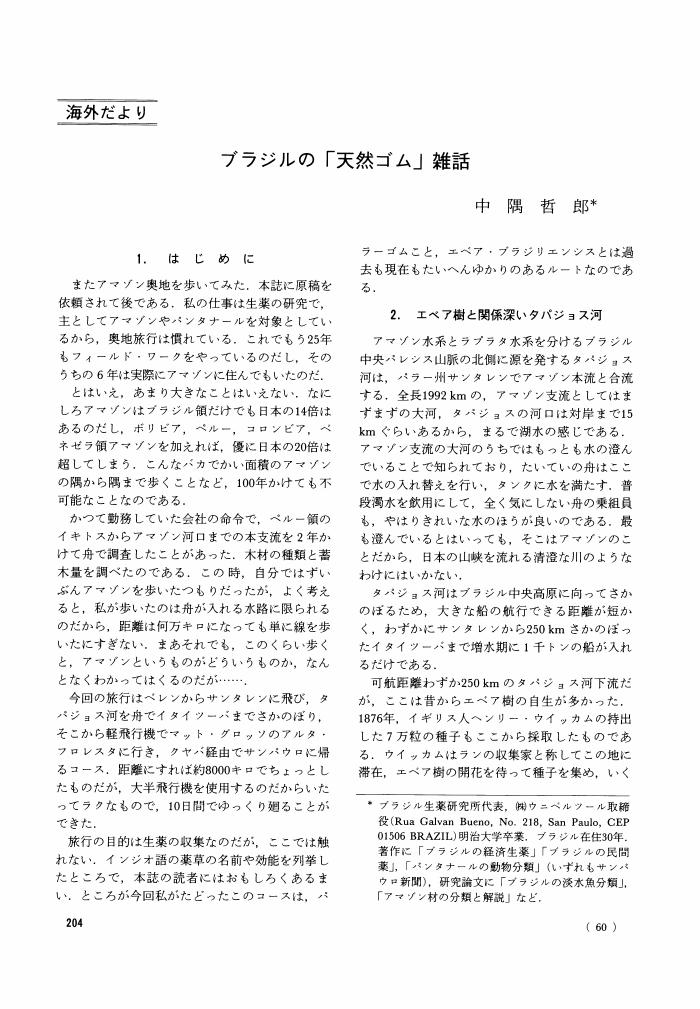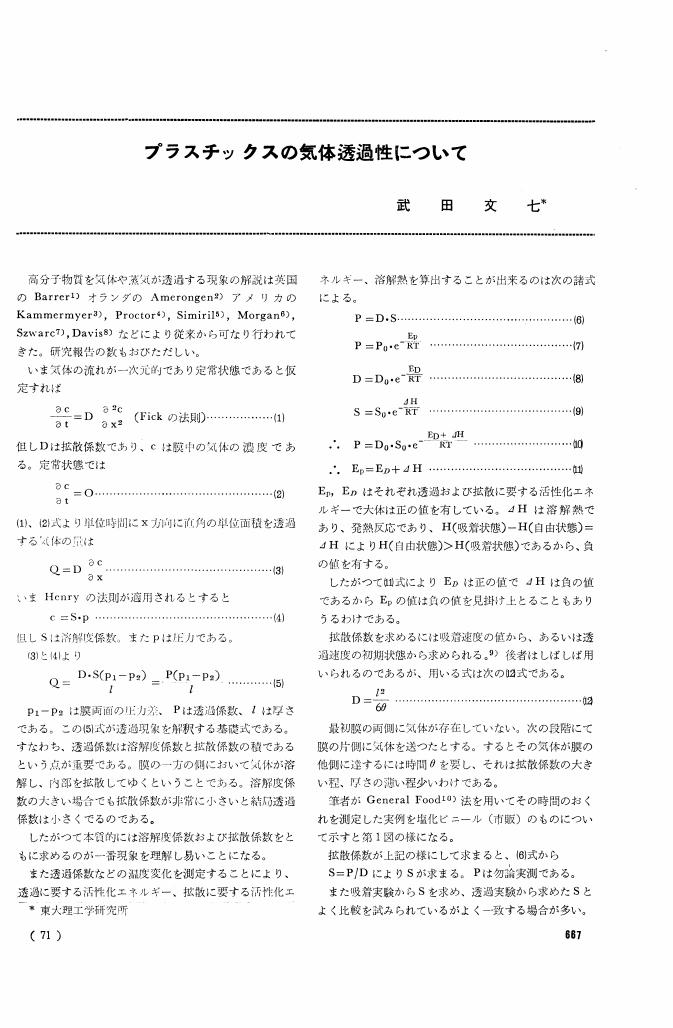1 0 0 0 OA 色安定性
- 著者
- 坂本 典雄
- 出版者
- 一般社団法人 日本ゴム協会
- 雑誌
- 日本ゴム協会誌 (ISSN:0029022X)
- 巻号頁・発行日
- vol.38, no.10, pp.962-968, 1965-10-15 (Released:2009-10-16)
- 参考文献数
- 6
1 0 0 0 OA 加硫天然ゴムの化学劣化機構に関する一つの結論
- 著者
- 村上 謙吉
- 出版者
- 一般社団法人 日本ゴム協会
- 雑誌
- 日本ゴム協会誌 (ISSN:0029022X)
- 巻号頁・発行日
- vol.47, no.1, pp.62-64, 1974-01-15 (Released:2009-10-16)
- 参考文献数
- 11
- 被引用文献数
- 1 1
1 0 0 0 OA 老化防止剤における最近の動向
- 著者
- 藤原 邦彦 上野 恒明
- 出版者
- 一般社団法人 日本ゴム協会
- 雑誌
- 日本ゴム協会誌 (ISSN:0029022X)
- 巻号頁・発行日
- vol.63, no.10, pp.625-638, 1990 (Released:2007-07-09)
- 参考文献数
- 46
- 被引用文献数
- 6 2
1 0 0 0 OA アニオン重合の基礎から最近の進歩 1. アニオン重合の基礎
- 著者
- 杉山 賢次 平尾 明
- 出版者
- 一般社団法人 日本ゴム協会
- 雑誌
- 日本ゴム協会誌 (ISSN:0029022X)
- 巻号頁・発行日
- vol.79, no.11, pp.543-549, 2006-11-15 (Released:2010-03-12)
- 参考文献数
- 26
- 被引用文献数
- 1 1
As a general introduction to anionic polymerization, this paper will review the categorization of anionic initiators and vinyl monomers according to Q-e values, the nature of carbanions in solution, especially their interaction with counter ions, the controlling of stereochemistry from 1, 3-diene and alkyl methacrylate polymerizations, and the basics of ring-opening polymerization. Vinyl monomers are categorized into four groups according to Q-e values. The anionic polymerizable monomers with higher Q values than 0.2 depend on their e values relating to the electron density on vinyl groups. The polymerization of high reactive monomers can be initiated with weak nucleophiles, while strong nucleophiles are required to initiate the polymerization of low reactive monomers. On the other hand, the relationship between reactivities of monomers and their active chain ends is basically inverse order. In order to understand the kinetics and mechanisms of anionic polymerization, the equilibriums among of the contact ion pair, the solvent separated ion pair, and free ion are discussed in terms of the reactivity of polystyryl anions. The dependence of stereochemistry of 1, 3-diene monomer and alkyl methacrylate polymerizations on the counter cation, solvent, and additive is described.
1 0 0 0 OA アマゾン奥地に野生のゴムの木を訪ねて 天然ゴムラテックスの放射線加硫をめぐって
- 著者
- 幕内 恵三
- 出版者
- 一般社団法人 日本ゴム協会
- 雑誌
- 日本ゴム協会誌 (ISSN:0029022X)
- 巻号頁・発行日
- vol.69, no.10, pp.687-692, 1996 (Released:2007-07-09)
- 参考文献数
- 9
- 被引用文献数
- 1
1 0 0 0 OA ゴム引布の今昔
- 著者
- 斎藤 惇
- 出版者
- 一般社団法人 日本ゴム協会
- 雑誌
- 日本ゴム協会誌 (ISSN:0029022X)
- 巻号頁・発行日
- vol.55, no.2, pp.65-70, 1982 (Released:2007-07-09)
- 参考文献数
- 10
- 被引用文献数
- 1
1 0 0 0 OA ブラジルの「天然ゴム」雑話
- 著者
- 中隅 哲郎
- 出版者
- 一般社団法人 日本ゴム協会
- 雑誌
- 日本ゴム協会誌 (ISSN:0029022X)
- 巻号頁・発行日
- vol.63, no.4, pp.204-208, 1990 (Released:2007-07-09)
- 被引用文献数
- 2 1
1 0 0 0 OA 有機金属化学の基礎から最近の進歩まで 第5回 遷移金属錯体を用いた均一系触媒反応2
- 著者
- 小宮 三四郎
- 出版者
- 一般社団法人 日本ゴム協会
- 雑誌
- 日本ゴム協会誌 (ISSN:0029022X)
- 巻号頁・発行日
- vol.89, no.2, pp.42-49, 2016 (Released:2016-03-25)
- 参考文献数
- 37
Homogeneous catalysis promoted by transition metal complexes such as hydrometallation, carbonylation, Wacker oxidation, oxidative coupling reaction are described. Mechanistic aspects of these catalytic reactions are discussed on the basis of the fundamental reaction patterns of organotransiton metal complexes such as ligand dissociation and association, oxidative addition and reductive elimination, insertion and elimination, and reactions of the coordinated substrates.
1 0 0 0 OA 合成高分子製スキャホールドの表面力学特性が細胞接着に及ぼす効果
- 著者
- 松野 寿生 田中 敬二
- 出版者
- 一般社団法人 日本ゴム協会
- 雑誌
- 日本ゴム協会誌 (ISSN:0029022X)
- 巻号頁・発行日
- vol.87, no.10, pp.434-439, 2014 (Released:2015-04-29)
- 参考文献数
- 18
The adhesion of L929 fibroblast on polymer bilayers composed of a glassy polystyrene (PS) prepared on the top of a rubbery polyisoprene (PI) was examined. Since the top PS layer is not built on a glassy foundation, the system becomes mechanically unstable with decreasing thickness of the PS layer. When the PS film was thinner than 25 nm,the number of cells adhered to the surface decreased and the cells could not be well spread. Fluorescence microscopic observations revealed that the formation of F-actin filaments in cells attached to the bilayers was more pronounced with a thicker PS film than with a thinner one. On the other hand, the thickness dependence of the cell adhesion was not observed for the PS monolayer films. Taking into account that the amount of adsorbed protein molecules was independent of the PS layer thickness of the bilayer films, our results indicate that cells, unlike protein molecules,could sense mechanical properties derived from the deeper region of the scaffold.
1 0 0 0 OA カーボンナノチューブ充塡ゴム材料の特徴と応用
- 著者
- 阿多 誠介
- 出版者
- 一般社団法人 日本ゴム協会
- 雑誌
- 日本ゴム協会誌 (ISSN:0029022X)
- 巻号頁・発行日
- vol.90, no.4, pp.200-205, 2017 (Released:2017-06-27)
- 参考文献数
- 19
Carbon nanotube (CNT) was found in 1991 by Dr. Iijima, and it has attracted wide attention because of its high mechanical properties along with high electrical and thermal conductivities. However, practical application of carbon nanotube has not been achieved yet. In this article, I repot promising applications of CNT and rubber composite such as high thermal conductive flexible sheet (TIM), stretchable electric wire for devices, high wear resistant material and high thermal durable materials for shielding field. Furthermore, I also report the importance of CNT dispersion for getting high performance the CNT and rubber composite. Just after the synthesis, CNTs form bundled structure. To derive the structural advantage of CNT for filler, de-bundling is important.
1 0 0 0 OA 密閉式混合機を中心としたゴムの混練
- 著者
- 山本 雅美
- 出版者
- 一般社団法人 日本ゴム協会
- 雑誌
- 日本ゴム協会誌 (ISSN:0029022X)
- 巻号頁・発行日
- vol.45, no.4, pp.338-344, 1972-04-15 (Released:2009-10-16)
1 0 0 0 OA 最近のRTVシリコーンゴム
- 著者
- 深山 美代治
- 出版者
- 一般社団法人 日本ゴム協会
- 雑誌
- 日本ゴム協会誌 (ISSN:0029022X)
- 巻号頁・発行日
- vol.62, no.12, pp.758-766, 1989 (Released:2008-04-16)
- 参考文献数
- 4
- 被引用文献数
- 1
1 0 0 0 OA 有機金属化学の基礎から最近の進歩まで 第1回 有機遷移金属化学の基礎-化学結合の考え方
- 著者
- 小宮 三四郎
- 出版者
- 一般社団法人 日本ゴム協会
- 雑誌
- 日本ゴム協会誌 (ISSN:0029022X)
- 巻号頁・発行日
- vol.88, no.7, pp.270-275, 2015 (Released:2015-09-10)
- 参考文献数
- 20
- 被引用文献数
- 1
Fundamental minimum basic ideas for understanding structure and chemical bond of organotransition metal compounds as well as mechanisms of transition metal promoted catalyses and organic chemical transformations including bonding concepts, orbital hybridization, electron-deficient bond, back-donation, 18-electron rule, coordinative unsaturation, crystal field theory, fluxionality, nomenclature are described.
1 0 0 0 OA “感性”スポーツ品
- 著者
- 林田 直利
- 出版者
- 一般社団法人 日本ゴム協会
- 雑誌
- 日本ゴム協会誌 (ISSN:0029022X)
- 巻号頁・発行日
- vol.63, no.3, pp.137-143, 1990 (Released:2007-07-09)
1 0 0 0 OA ラテックス技術講座(1)
- 著者
- 国沢 新太郎
- 出版者
- 一般社団法人 日本ゴム協会
- 雑誌
- 日本ゴム協会誌 (ISSN:0029022X)
- 巻号頁・発行日
- vol.45, no.12, pp.1042-1045, 1972 (Released:2008-04-16)
1 0 0 0 OA ゴムの工業的合成法 第16回 天然ゴム
- 著者
- 渡辺 訓江 近藤 肇
- 出版者
- 一般社団法人 日本ゴム協会
- 雑誌
- 日本ゴム協会誌 (ISSN:0029022X)
- 巻号頁・発行日
- vol.90, no.4, pp.210-214, 2017 (Released:2017-06-27)
- 参考文献数
- 13
- 被引用文献数
- 1
Natural rubber (NR) is polyisoprene with 100% of cis-1,4 structure on main chain. NR is a natural resource derived from a tropical tree called Hevea brasiliensis (para rubber tree) that produces latex. NR is an industrial raw material, and global NR production and consumption are about 12 million ton per year (2014) which are about 40% in total rubber usage. Since NR shows superior physical properties such as break strength or durability comparing with synthetic rubber, NR demand is expected to rise in the future. In this review, we describe the present state, trend of new research and development of NR.
1 0 0 0 OA ホース
- 著者
- 横井 勝彦 増実 二郎
- 出版者
- 一般社団法人 日本ゴム協会
- 雑誌
- 日本ゴム協会誌 (ISSN:0029022X)
- 巻号頁・発行日
- vol.54, no.2, pp.94-101, 1981 (Released:2008-04-16)
- 参考文献数
- 22
- 被引用文献数
- 1
1 0 0 0 OA ゴム技術者のための入門講座〔III〕わかりやすいゴムの物性(10) 電気物性
- 著者
- 志賀 徹也
- 出版者
- 一般社団法人 日本ゴム協会
- 雑誌
- 日本ゴム協会誌 (ISSN:0029022X)
- 巻号頁・発行日
- vol.53, no.11, pp.658-665, 1980 (Released:2008-04-16)
- 参考文献数
- 8
1 0 0 0 OA アクリル酸エステル誘導体の共役置換反応を利用した機能高分子合成
- 著者
- 髙坂 泰弘
- 出版者
- 一般社団法人 日本ゴム協会
- 雑誌
- 日本ゴム協会誌 (ISSN:0029022X)
- 巻号頁・発行日
- vol.91, no.11, pp.400-405, 2018 (Released:2019-04-23)
- 参考文献数
- 42
Conjugate substitution reaction of α-(halomethyl) acrylates that proceeds in addition-elimination (SN2’) mechanism is attractive for polymer chemists, because it undergoes under ambient conditions in quantitative yields to afford α-(substituted methyl) acrylates. In this report, the conjugate substitution reaction is applied to elemental reactions in polymer chemistry, including termination of stereospecific living anionic polymerization, polycondensation, and main chain scission.
1 0 0 0 OA プラスチックスの気体透過性について
- 著者
- 武田 文七
- 出版者
- 一般社団法人 日本ゴム協会
- 雑誌
- 日本ゴム協会誌 (ISSN:0029022X)
- 巻号頁・発行日
- vol.29, no.8, pp.667-675, 1956-08-15 (Released:2013-03-05)
- 参考文献数
- 40
- 被引用文献数
- 2












